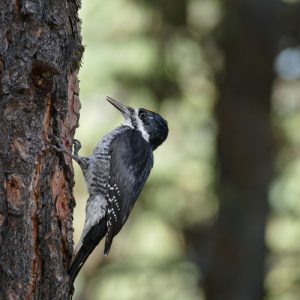
(Picoides arcticus)
Physical Characteristics: Solid black backs, striped black and white sides, while throats, chests, and bellies are white. Faces are black with white/black mustache marks, males have yellow caps. Can grow 9.1 inches in length and weigh between 2.2 – 3.1 ounces.
Diet: Feeds heavily on wood-boring beetle larvae; other insects, spiders, fruits and nuts.
Habitat: Fir/Spruce boreal forests, as well as Douglas-fir, hemlock, tamarack and pine. Favors burned and flooded areas with standing dying or dead trees – follows the path of bark beetles. Forests of North Central Idaho offer excellent habitat, though fire suppression and thinning reduces habitat.
Range: Across Canada, central/southern Alaska, western Montana, northern Idaho, throughout Cascade Range in Washington and Oregon, parts of Sierra Nevada Range in California, as well as northeastern United States.
Reproduction: Typically lays 3 – 4 white eggs annually. Male and females incubate eggs approximately 14 days. Both parents feed young, with males traveling longer distances. Young disperse nest about 25 days after hatching.
Threats: Rely intensively on wildland fire and forest mosaics to produce habitat and food. Fire suppression, thinning and salvage logging (post-fire) threaten species. As a result, forest management in Clearwater Basin is problematic.
Miscellaneous: Not migratory but moves with prey and climate conditions.
Return to main Native Species page.